Auxiliary power unit

An auxiliary power unit (APU) is a device on a vehicle that provides energy for functions other than propulsion. They are commonly found on large aircraft and naval ships as well as some large land vehicles. Aircraft APUs generally produce 115 V alternating current (AC) at 400 Hz (rather than 50/60 Hz in mains supply), to run the electrical systems of the aircraft; others can produce 28 V direct current (DC).[1] APUs can provide power through single- or three-phase systems.
Transport aircraft
Function
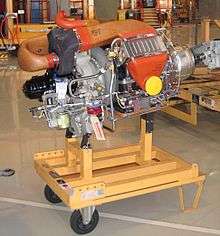
The primary purpose of an aircraft APU is to provide power to start the main engines. Turbine engines must be accelerated to a high rotational speed to provide sufficient air compression for self-sustaining operation. Smaller jet engines are usually started by an electric motor, while larger engines are usually started by an air turbine motor. Before the engines are to be turned, the APU is started, generally by a battery or hydraulic accumulator. Once the APU is running, it provides power (electric, pneumatic, or hydraulic, depending on the design) to start the aircraft's main engines.
To start, a jet engine requires pneumatic rotation of the turbine, AC-electrical fuel pumps, and an AC-electrical "flash" that ignites the fuel. As the turbine (behind the combustion chamber) is already rotating, the front inlet fans are also rotating. After the ignition, both fans and turbine speed up their rotation. As combustion stabilizes, the engine thereafter only needs the fuel to run at idle. The started engine can now replace the APU when starting up further engines. During flight the APU and its generator are not needed.
APUs are also used to run accessories while the engines are shut down. This allows the cabin to be comfortable while the passengers are boarding before the aircraft's engines are started. Electrical power is used to run systems for preflight checks. Some APUs are also connected to a hydraulic pump, allowing crews to operate hydraulic equipment (such as flight controls or flaps) prior to engine start. This function can also be used, on some aircraft, as a backup in flight in case of engine or hydraulic failure.
Aircraft with APUs can also accept electrical and pneumatic power from ground equipment when an APU has failed or is not to be used. Some airports reduce the use of APUs due to noise and pollution, and ground power is used when possible.[2][3]
APUs fitted to extended-range twin-engine operations (ETOPS) aircraft are a critical safety device, as they supply backup electricity and compressed air in place of the dead engine or failed main engine generator. While some APUs may not be startable in flight, ETOPS-compliant APUs must be flight-startable at altitudes up to the aircraft service ceiling. Recent applications have specified starting up to 43,000 ft (13,000 m) from a complete cold-soak condition such as the Hamilton Sundstrand APS5000 for the Boeing 787 Dreamliner. If the APU or its electrical generator is not available, the aircraft cannot be released for ETOPS flight and is forced to take a longer non-ETOPS route.
APUs providing electricity at 400 Hz are smaller and lighter than their 50/60 Hz counterparts, but are costlier; the drawback being that such high frequency systems suffer from voltage drops.[1]
History
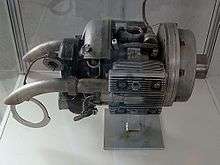
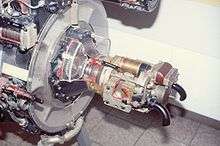
During World War I, the British Coastal class blimps, one of several types of airship operated by the Royal Navy, carried a 1.75 horsepower (1.30 kW) ABC auxiliary engine. These powered a generator for the craft's radio transmitter and, in an emergency, could power an auxiliary air blower.[Note 1][4] One of the first military fixed-wing aircraft to use an APU was the British, World War 1, Supermarine Nighthawk, an anti-Zeppelin Night fighter.[5]
During World War II, a number of large American military aircraft were fitted with APUs. These were typically known as putt–putts, even in official training documents. The putt-putt on the B-29 Superfortress bomber was fitted in the unpressurised section at the rear of the aircraft. Various models of four-stroke, Flat-twin or V-twin engines were used. The 7 horsepower (5.2 kW) engine drove a P2, DC generator, rated 28.5 Volts and 200 Amps (several of the same P2 generators, driven by the main engines, were the B-29's DC power source in flight). The putt-putt provided power for starting the main engines and was used after take-off to a height of 10,000 feet (3,000 m). The putt-putt was restarted when the B-29 was descending to land.[6]
Some models of the B-24 Liberator had a putt–putt fitted at the front of the aircraft, inside the nose-wheel compartment.[7] Some models of the Douglas C-47 Skytrain transport aircraft carried a putt-putt under the cockpit floor.[8]
The first German jet engines built during the Second World War used a mechanical APU starting system designed by the German engineer Norbert Riedel. It consisted of a 10 horsepower (7.5 kW) two-stroke flat engine, which for the Junkers Jumo 004 design was hidden in the intake diverter, essentially functioning as a pioneering example of an auxiliary power unit for starting a jet engine. A hole in the extreme nose of the centrebody contained a manual pull-handle which started the piston engine, which in turn rotated the compressor. Two small petrol tanks were fitted in the annular intake. The engine was considered an extreme short stroke (bore / stroke: 70 mm / 35 mm = 2:1) design so it could fit in the hub of the turbine compressor. For reduction it had an integrated planetary gear. It was produced in Victoria in Nuremberg and served as a mechanical APU-style starter for all three German jet engine designs to have made it to at least the prototype stage before May 1945: the Junkers Jumo 004, the BMW 003, and the prototypes (19 built) of the more advanced Heinkel HeS 011 engine, which mounted it just above the intake passage in the Heinkel-crafted sheetmetal of the engine nacelle nose.[9]
The Boeing 727 in 1963 was the first jetliner to feature a gas turbine APU, allowing it to operate at smaller airports, independent from ground facilities. The APU can be identified on many modern airliners by an exhaust pipe at the aircraft's tail.[10]
Sections
A typical gas turbine APU for commercial transport aircraft comprises three main sections:
- Power section
The power section is the gas generator portion of the engine and produces all the shaft power for the APU.
- Load compressor section
The load compressor is generally a shaft-mounted compressor that provides pneumatic power for the aircraft, though some APUs extract bleed air from the power section compressor. There are two actuated devices: the inlet guide vanes that regulate airflow to the load compressor and the surge control valve that maintains stable or surge-free operation of the turbo machine.
- Gearbox section
The gearbox transfers power from the main shaft of the engine to an oil-cooled generator for electrical power. Within the gearbox, power is also transferred to engine accessories such as the fuel control unit, the lubrication module, and cooling fan. In addition, there is also a starter motor connected through the gear train to perform the starting function of the APU. Some APU designs use a combination starter/generator for APU starting and electrical power generation to reduce complexity.
On the Boeing 787 more-electric aircraft, the APU delivers only electricity to the aircraft. The absence of a pneumatic system simplifies the design, but high demand for electricity requires heavier generators.[11][12]
Onboard solid oxide fuel cell (SOFC) APUs are being researched.[13]
Manufacturers
Two main corporations compete in the aircraft APU market: United Technologies Corporation (through its subsidiaries Pratt & Whitney Canada and Pratt & Whitney AeroPower), and Honeywell International Inc.
Military aircraft
Smaller military aircraft, such as fighters and attack aircraft, feature auxiliary power systems which are different from those used in transport aircraft. The functions of engine starting and providing electrical and hydraulic power are divided between two units, the jet fuel starter and the emergency power unit.
- Jet fuel starter
A jet fuel starter (JFS) is a small turboshaft engine designed to drive a jet engine to its self-accelerating RPM. Rather than supplying bleed air to a starter motor in the manner of an APU, a JFS output shaft is mechanically connected to an engine. As soon as the JFS begins to turn, the engine turns; unlike APUs, these starters are not designed to produce electrical power when engines are not running.
Jet fuel starters use a free power turbine section, but the method of connecting it to the engine depends on the aircraft design. In single-engine aircraft such as the A-7 Corsair II and F-16 Fighting Falcon, the JFS power section is always connected to the main engine through the engine's accessory gearbox. In contrast, the twin-engine F-15 Eagle features a single JFS, and the JFS power section is connected through a central gearbox which can be engaged to one engine at a time. On the F-15, the jet fuel starter (JFS) is mated with a central gearbox (CGB). The CGB has extendable pawl shafts that extend out to reach the aircraft mounted accessory drive (AMAD) mounted in front of each engine. The AMAD is connected to the jet engine by the power takeoff (PTO) shaft. As the engine accelerates to starting speed, the PTO shaft becomes the method to drive the AMAD during flight. Once the aircraft engine has started and begins driving the AMAD, the pawl shaft on the CGB returns to its retracted position and the JFS is shut down.
- Emergency power unit
Emergency hydraulic and electric power are provided by a different type of gas turbine engine. Unlike most gas turbines, an emergency power unit has no gas compressor or ignitors, and uses a combination of hydrazine and water, rather than jet fuel. When the hydrazine and water mixture is released and passes across a catalyst of iridium, it spontaneously ignites, creating hot expanding gases which drive the turbine. The power created is transmitted through a gearbox to drive an electrical generator and hydraulic pump.
The hydrazine is contained in a sealed, nitrogen charged accumulator. When the system is armed, the hydrazine is released whenever the engine-driven generators go off-line, or if all engine-driven hydraulic pumps fail.
Airport equipment
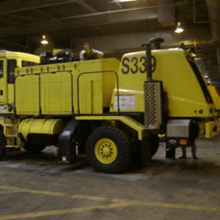
Many airports have adopted APUs as a solution to high fuel consumption. Much of the equipment used to clean and clear runways will use an average of two or more gallons per hour of diesel while idling. Adding an APU will provide power, heating and cooling as well as hydraulic warming if necessary and can result in significant fuel and maintenance savings.
Spacecraft
The Space Shuttle APUs provided hydraulic pressure. The Space Shuttle had three redundant APUs, powered by hydrazine fuel. They were only powered up for ascent, re-entry, and landing. During ascent, the APUs provided hydraulic power for gimballing of the Shuttle's three engines and control of their large valves, and for movement of the control surfaces. During landing, they moved the control surfaces, lowered the wheels, and powered the brakes and nose-wheel steering. Landing could be accomplished with only one APU working.[14] In the early years of the Shuttle there were problems with APU reliability, with malfunctions on three of the first nine Shuttle missions.[Note 2]
Armor
APUs are fitted to some tanks to provide electrical power without the high fuel consumption and large infrared signature of the main engine. Both the M1 Abrams and variants of the Leopard 2 such as the Spanish and Danish variants carry the APU in the rear right hull section. The British Centurion tank used an Austin A-Series inline-4 as its auxiliary power unit. The Turkish self-propelled howitzer T-155 Fırtına uses a 2-stroke diesel engine located at the rear right hull to supply power to fire control computers and turret hydraulics.
Towed artillery
Many modern towed artillery pieces are fitted with internal combustion engines, primarily to provide hydraulic power to aid in gun laying and to power flick rammers or other aids to loading. These engines can also be used to provide limited battlefield mobility when no artillery tractors are available.
Commercial vehicles
A refrigerated or frozen food semi trailer or train car may be equipped with an independent APU and fuel tank to maintain low temperatures while in transit, without the need for an external transport-supplied power source.
In the United States, federal Department of Transportation regulations require 10 hours of rest for every 11 hours of driving. When stopped, drivers often idle their engines to provide heat, light, and power. Idling inefficiently burns fuel and puts wear on engines. Some trucks carry an APU designed to eliminate these long idles. An APU can save up to 20 US gallons (76 L) (Cat 600 – 10 hours downtime @ 2 gallons per hour idling) of fuel a day, and can extend the useful life of the main engine by around 100,000 miles (160,000 km), by reducing non-productive run time.
On some older diesel engines, an APU was used instead of an electric motor to start the main engine. These were primarily used on large pieces of construction equipment.
Diesel
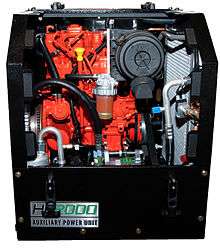
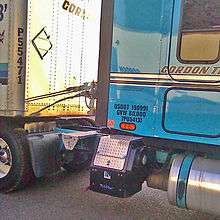
The most common APU for a commercial truck is a small diesel engine with its own cooling system, heating system, generator or alternator system with or without inverter, and air conditioning compressor, housed in an enclosure and mounted to one of the frame rails of a semi-truck. Other designs fully integrate the auxiliary cooling, heating, and electrical components throughout the chassis of the truck. The APU generator engine is a fraction of the main engine's size and uses a fraction of the fuel; some models can run for eight hours on 1 US gallon (3.8 L) of diesel. The generator also powers the main engine's block and fuel system heaters, so the main engine can be started easily right before departure if the APU is allowed to run for a period beforehand. These units are used to provide climate control and electrical power for the truck's sleeper cab and engine block heater during downtime on the road as mandated by statewide laws for idle reduction.
Propane
A less common APU available for commercial diesel truck cabs and sleepers includes a heating & cooling system, duplex 110 volt electrical power outlets inside and outside the cab. These are all powered by a single propane fueled generator. The Tri Pac III APU was introduced to the market in 2012 by American Truck Group, LLC. With this system in place, it is no longer necessary to idle the truck engine during rest and sleep periods in order to provide the air condition/heating and appliance power for the driver. This will reduce non travel operating hours on the engine and extend its useful mileage by up to an estimated 100,000 miles.[19]
Electric
Electric APUs have started gaining acceptance. These electric APUs use battery packs instead of the diesel engine on traditional APUs as a source of power. The APU's battery pack is charged when the truck is in motion. When the truck is idle, the stored energy in the battery pack is then used to power an air conditioner, heater, and other devices (television, microwave oven, etc.) in the bunk.
Fuel cells
In recent years, truck and fuel cell manufacturers have teamed up to create, test and demonstrate a fuel cell APU that eliminates nearly all emissions[20] and uses diesel fuel more efficiently.[21] In 2008, a DOE sponsored partnership between Delphi Electronics and Peterbilt demonstrated that a fuel cell could provide power to the electronics and air conditioning of a Peterbilt Model 386 under simulated "idling" conditions for 10 hours.[22] Delphi has said the 5 kW system for Class 8 trucks will be released in 2012, at an $8000–9000 price tag that would be competitive with other "midrange" two-cylinder diesel APUs, should they be able to meet those deadlines and cost estimates.[21]
Other forms of transport
Where the elimination of exhaust emissions or noise is particularly important (such as yachts, camper vans), fuel cells and photovoltaic modules are used as APUs for electricity generation.
APUs are installed on some diesel locomotives, allowing the prime mover to be shut down during extended layovers. This provides power and heat to maintain air pressure, provide battery charging and prevent the prime mover coolant from freezing.
See also
- Air start system
- Auxiliary hydraulic system
- Coffman engine starter - a similar system which uses an explosive cartridge to supply gas pressure
- Ram air turbine
Notes
- ↑ A continuous supply of pressurized air was needed to keep the airship's Ballonets inflated, and so maintain the structure of the gasbag. In normal flight, this was collected from the propeller slipstream by air scoop
- ↑ Early Shuttle APU malfunctions:
- STS-2 (November 1981): During a launchpad hold, high oil pressures were discovered in two of the three APUs. The gear boxes needed to be flushed and filters replaced, forcing the launch to be rescheduled.[15]
- STS-3 (March 1982): One APU overheated during ascent and had to be shut down, although it later functioned properly during re-entry and landing.[16][17]
- STS-9 (November–December 1983): During landing, two of the three APUs caught fire.[18]
References
- 1 2 "400 Hz Electrical Systems". Ask a Rocket Scientist. Aerospaceweb.org.
- ↑ "Airport Noise and Emissions Regulations". Suvarnabhumi International Airport / Boeing. March 2011. Archived from the original on 1 December 2013. Retrieved 22 January 2013.
- ↑ Nielsen, Erik. "Copenhagen Airport, Use of auxiliary power unit (APU)". Copenhagen Airport / Boeing. p. 6.5. Retrieved 22 January 2013.
- ↑ Abbott, Patrick (1989). The British Airship at War, 1914-1918. Terence Dalton. p. 57. ISBN 0861380738.
- ↑ Andrews and Morgan 1987, p. 21.
- ↑ Wolf, William (2005). Boeing B-29 Superfortress: the ultimate look : from drawing board to VJ-Day. Schiffer. p. 205. ISBN 0764322575.
- ↑ Livingstone, Bob (1998). Under the Southern Cross: The B-24 Liberator in the South Pacific. Turner Publishing Company. p. 162. ISBN 1563114321.
- ↑ Ethell, Jeffrey; Downie, Don (2004). Flying the Hump: In Original World War II Color. Zenith Imprint. p. 84. ISBN 0760319154.
- ↑ Gunston 1997, p. 141.
- ↑ Vanhoenacker, Mark (5 February 2015). "What Is That Hole in the Tail of an Airplane?". Slate (magazine). Retrieved 20 October 2016.
- ↑ Sinnet, Mike (2007). "Saving Fuel and enhancing operational efficiencies" (PDF). Boeing. Retrieved January 17, 2013.
- ↑ Ogando, Joseph, ed. (June 4, 2007). "Boeing's 'More Electric' 787 Dreamliner Spurs Engine Evolution: On the 787, Boeing eliminated bleed air and relied heavily on electric starter generators". Design News. Retrieved September 9, 2011.
- ↑ Spenser, Jay (July 2004). "Fuel cells in the air". Boeing Frontiers. 3 (3).
- ↑ "Hydraulic System". spaceflight.nasa.gov. NASA. Retrieved 8 February 2016.
- ↑ "Space Shuttle Mission Archives STS-2". www.nasa.gov. NASA. Retrieved 18 February 2016.
- ↑ "Space Shuttle Mission Archives STS-3". www.nasa.gov. NASA. Retrieved 18 February 2016.
- ↑ Lousma, Jack R. (15 March 2010). "Jack R. Lousma Edited Oral History Transcript". NASA Johnson Space Center Oral History Project (Interview). Interview with Ross-Nazzal, Jennifer. Retrieved 18 February 2016.
- ↑ "Space Shuttle Mission Archives STS-9". www.nasa.gov. NASA. Retrieved 18 February 2016.
- ↑ "Propane APU". American Truck Group. Retrieved 20 August 2015.
- ↑ Broderick, Christie-Joy; Timothy Lipman; Mohammad Farshchi; Nicholas Lutsey; Harry Dwyer; Daniel Sperling; William Gouse; Bruce Harris; Foy King (2002). "Evaluation of Fuel Cell auxiliary Power Units for Heavy-Duty Diesel Trucks" (PDF). Transportation Research Part D. Elsevier Sciences Ltd. pp. 303–315. Retrieved 2011-09-27.
- 1 2 Weissler, Paul (2010-05-12). "Delphi truck fuel-cell APU to hit road in 2012". Vehicle Electrification. Retrieved 2011-09-27.
and Delphi says it will have a 5-kW APU on the market in 2012.
- ↑ Jacobs, Mike (2009-03-19). "Solid Oxide Fuel Cell Successfully Powers Truck Cab and Sleeper in DOE-Sponsored Test". NETL: News Release. National Energy Technology Laboratory. Retrieved 2011-09-27.
External links
| Wikimedia Commons has media related to Auxiliary power units. |
- "Space Shuttle Orbiter APU"
- "Sound of an APU from inside a Boeing 737 cabin"
- The Riedel Starter Motor In: Messerschmitt Me 262B in Detail; The airframe, engines and canopy